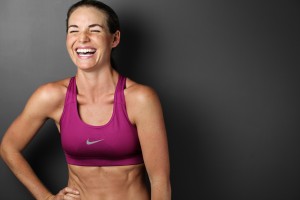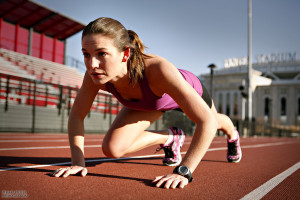With teaching group classes, I always welcome questions during and after class. I thought it may be helpful to highlight some questions that have popped up frequently, and answer them as I have in person. After all, if folks I have coached in person have brought up the following questions numerous times, the odds are some of you may also have the same questions. Let’s get cracking!
What are the best kind of running shoes?
Despite what shoe manufacturers will tell you, there is no one shoe that is the perfect shoe for all runners. If a sales person tells you that their brand or style is perfect for you, run for the hills. Your feet, body weight, stride, weekly miles, terrain, experience, injury history – all are factors when finding the right shoe for you and your running career. I would, however, recommend you keep the following brands in mind when shopping: Mizuno, Brooks, and Asics. These brands are popular with mid-long distance runners, and are the brands of choice at most races. That doesn’t mean those brands are right for you. A shoe should feel like an extension of your foot. If it doesn’t, it’s not right. If you are in the right shoe, insoles and orthotics shouldn’t be necessary.
Are there workouts I can do to trim and tone my thighs?
You cannot target one body area for weight loss and body fat. If you want more definition, you need to lose body fat percentage in general. Zoning in, targeting, etc – that’s not how our bodies work. You can tone up by weight training and losing body fat – that combination will give you visual results. However, based on your genetics, you may never have thin or toned thighs – for example. Your thighs may be the last place you’ll lose body fat, and the dedication to lose that final bit may be extremely challenging. Instead, I would highly recommend folks looking to tone up focus of safely losing some body fat, and instead focus on weight training, and a healthy amount of cardio.
I have pain in my shins. What do I do?
Shin splints often occur when an athletes takes on too much too soon – going from little or zero mileage to running every day, running intense workouts too frequently, or running in old shoes. To help ease shin pain, stretch and foam roll your calf muscles, ice, and perhaps take some anti-inflammatory. Cutting back on mileage and intensity and focusing on some rest days will also help. If the pain continues, see a sports doctor or physical therapist. I am not a doctor, FYI.
I have been training really hard. How come I am not seeing an improvement in my speed?
Improvements in fitness sometimes take time, and very rarely can you expect to see or feel huge improvements in a few days or a week. In fact, you should expect to put in hard work for a few weeks or months before improvements appear by leaps and bounds. Remember that rest and recovery is just as important as the hard work, so if you are someone who rarely takes a day off or skimps on sleep, you may be getting in the way of your own success. Adding some additional rest and active recovery days may help your paces improve.
Is there a way to run on the treadmill that targets my butt?
If you are trying to target a muscle group like your glutes, hills can help. However, you also need to make sure you are activating your glutes and hamstrings. Many runners are quad runners, meaning we overuse our quads and don’t take advantage of the power our glutes and hamstrings offer us. If you are trying to gain strength, shape or size, you need to weight train that area. Running alone will not offer glute definition.
How do I know what my goal race paces or efforts should be?
This is sometimes hard to navigate. When setting your goals for the coming year, I encourage you to be ambitious but also realistic. For example, if your current Half Marathon best is 2:00, aiming for a 1:25 in your next Half Marathon is probably too ambitious. However, aiming for a 1:50 or 1:40 may be ambitious but also reasonable with hard work. If you achieve that goal, then work down to the 1:25. If you have taken a lot of time off from training, or are tackling a new distance, go by effort. This is especially true when training in heat or humidity. As you improve, your paces should hopefully drop towards your goal paces – though you may need to curve your expectations as you go further into training.
When trying to improve, should I focus on more miles or quality miles?
If you are just beginning your running journey, focus on slowly increasing your miles and keep the paces easy. Don’t go out and run hard, but instead focus on comfortable, conversational miles. Once you build the quantity up to a good number, you can then focus on quality – speed, hills, long runs, etc. If you are a runner who is already clocking consistent miles, focus on quality instead of quantity while training for a goal. Do the least amount of running necessary to achieve your goals – this may still mean 60 mile weeks while marathon training for your ambitious goal – but you also may be tempted to push to 70 mile weeks because you have heard more miles are better – but more miles means injury risk and chances for burnout increase.
Do you have questions for me? They can be anything running, nutrition, health or fitness related. If so, shoot me a comment, a message on twitter or FB, or in class next time.







